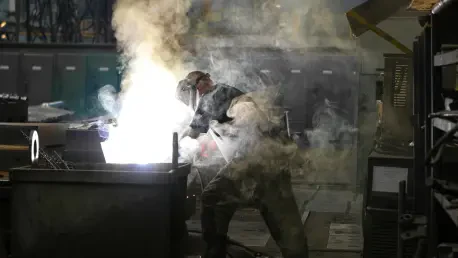Imagine a bustling factory floor where a worker, confident in their common sense, bypasses a safety protocol, believing accidents only happen in high-risk zones, only to face a preventable mishap moments later that leads to injury and downtime. This scenario, far too common across industries, underscores a critical issue: pervasive myths about workplace safety that endanger lives and livelihoods. Misconceptions can create a false sense of security, leaving employees and employers vulnerable to hazards that could be mitigated with the right knowledge. Addressing these myths is not just about compliance but about building a culture where safety is paramount for everyone involved.
The importance of shattering these outdated beliefs cannot be overstated. When myths persist, they foster complacency, increase the likelihood of incidents, and can even result in legal consequences for businesses. By exploring and debunking seven critical workplace safety myths, this guide aims to equip readers with actionable insights to enhance protection and promote a proactive approach to hazard prevention. The journey toward a safer workplace begins with understanding where misunderstandings lie and taking steps to correct them.
Unveiling the Hidden Dangers of Workplace Safety Myths
Workplace safety stands as a cornerstone of any thriving organization, yet hidden dangers lurk in the form of widely accepted misconceptions. These myths often downplay the severity of risks, leading to inadequate precautions and, ultimately, preventable accidents. From offices to construction sites, the belief in false safety narratives can jeopardize employee well-being and disrupt operations, making it imperative to confront these fallacies head-on.
Debunking these myths is essential for fostering an environment where protection is prioritized over assumption. When employees and employers alike operate under incorrect notions, the potential for harm escalates, affecting not just individuals but entire teams through lost productivity and morale. Clearing up these misunderstandings helps build trust and ensures that safety measures are based on facts rather than flawed perceptions.
This guide will tackle seven deadly myths that undermine workplace safety, ranging from the belief that safety is solely an employer’s burden to the dangerous idea that mental health has no bearing on physical security. Each myth represents a barrier to effective protection, and by addressing them, organizations can take significant strides toward reducing risks. The following sections provide a roadmap for identifying and countering these misconceptions with practical, informed strategies.
Why Busting Safety Myths Matters for Everyone
Believing in workplace safety myths can have dire consequences, amplifying the risk of accidents and exposing organizations to legal liabilities. When employees assume that common sense alone suffices or that minor oversights are inconsequential, small errors can snowball into major incidents, causing injury or even loss of life. Beyond the human toll, businesses face financial burdens from medical costs, fines, and reputational damage due to negligence rooted in these false beliefs.
Shattering these myths offers substantial benefits, starting with improved employee well-being through a more secure environment. Fewer incidents translate to cost savings, as resources are not drained by emergency responses or downtime. Moreover, cultivating a robust safety culture enhances morale and productivity, as workers feel valued and protected, fostering a sense of unity and purpose across the organization.
The responsibility for safety does not rest with one party alone; it is a shared duty between employers and employees. Both must actively engage in identifying hazards, adhering to protocols, and advocating for continuous improvement. By working collaboratively to dispel myths, workplaces can create a foundation of trust and accountability, ensuring that safety remains a collective priority rather than a delegated task.
Dissecting the 7 Deadly Workplace Safety Myths
Understanding and countering workplace safety myths requires a detailed examination of each misconception, paired with actionable steps to replace fiction with fact. These myths often stem from outdated thinking or a lack of awareness, but their impact on real-world safety is profound. By dissecting each one, this section aims to provide clarity and guidance for implementing effective measures.
For every myth addressed, practical solutions and real-world relevance are offered to help organizations move beyond assumptions. The goal is to empower workplaces with the knowledge to proactively mitigate risks through informed practices, ensuring that safety is not just a policy but a lived value. Below, each myth is explored with insights to transform misunderstanding into meaningful action.
Myth 1: Safety Is Solely the Employer’s Responsibility
A prevalent misconception is that workplace safety falls exclusively on the shoulders of employers, leaving employees as passive recipients of protection. This belief undermines the reality that safety is a collective duty, requiring active participation from everyone at all levels. Employees must engage in identifying potential risks and reporting unsafe conditions to create a comprehensive defense against hazards.
To foster shared responsibility, organizations should encourage a culture where every individual feels empowered to contribute to safety efforts. This can be achieved by establishing clear channels for reporting concerns, conducting regular safety discussions, and recognizing contributions to hazard prevention. When everyone takes ownership, the workplace transforms into a collaborative space where risks are minimized through joint vigilance.
Real-World Impact: A Team Effort in Action
Consider a manufacturing plant where workers were initially hesitant to voice safety concerns, assuming it was management’s role. After implementing an anonymous reporting system and monthly safety meetings, employees began identifying overlooked risks, such as worn-out equipment. This shift in mindset led to a notable drop in minor incidents, proving that a team-oriented approach can significantly enhance protection.
Myth 2: Common Sense Is Enough for Safety
Many believe that intuitive knowledge or common sense is sufficient to navigate workplace hazards, dismissing the need for structured guidance. This dangerous assumption fails to account for the complexity of risks that vary across environments, often leading to misjudgments with severe consequences. Relying solely on instinct leaves workers unprepared for specific threats that require specialized understanding.
Specific, ongoing training is vital to equip employees with the skills needed to handle unique dangers effectively. Programs should cover equipment operation, emergency procedures, and hazard recognition, tailored to the workplace’s distinct challenges. By prioritizing education over assumption, organizations ensure that their workforce is not just reactive but proactively prepared for potential issues.
Case Study: Training Saves Lives
In a warehouse setting, workers once relied on guesswork to manage heavy machinery, believing their experience was enough. After a near-miss incident, the company introduced mandatory training on equipment safety protocols. Months later, a potential accident was averted when a trained employee recognized a malfunction and followed proper shutdown procedures, highlighting the life-saving value of structured learning.
Myth 3: Safety Training Is a One-Time Event
Another widespread myth is that a single safety training session fulfills all requirements for employee preparedness. This notion ignores the dynamic nature of workplaces, where new hazards emerge, equipment updates occur, and regulations evolve. A one-and-done approach leaves gaps in knowledge that can prove costly over time.
Continuous education is crucial to keep pace with changing risks and compliance standards. Regular refresher courses, updates on new protocols, and drills for emergency scenarios ensure that safety remains a current priority. By committing to ongoing learning, organizations can adapt to unforeseen challenges and maintain a high standard of protection.
Example: Adapting to New Risks
A tech firm once conducted safety training only during onboarding, assuming minimal risks in an office setting. When new ergonomic concerns arose from prolonged remote work setups, the company introduced quarterly updates on posture and workstation safety. This proactive adjustment reduced reported discomfort among staff, demonstrating the importance of evolving training to meet emerging needs.
Myth 4: Only High-Risk Industries Need Strong Safety Measures
The belief that only high-risk industries like construction or manufacturing require robust safety measures is a dangerous oversight. This myth suggests that environments perceived as low-risk, such as offices, are immune to hazards, ignoring the reality of slips, electrical issues, or ergonomic injuries that can occur anywhere. Such thinking diminishes the need for vigilance across all sectors.
Every workplace, regardless of industry, benefits from a strong safety culture that addresses both obvious and subtle risks. Implementing policies for regular inspections, hazard awareness, and employee training ensures comprehensive protection, no matter the setting. Recognizing that danger is not confined to certain fields encourages a universal commitment to precaution.
Insight: Office Hazards Uncovered
An accounting firm once overlooked safety protocols, assuming their office was risk-free. A sudden electrical fault in outdated wiring caused a small fire, prompting a full safety overhaul with updated equipment checks and evacuation drills. This incident revealed that even seemingly safe spaces require diligent measures to prevent unexpected threats from escalating.
Myth 5: Minor Safety Oversights Are No Big Deal
Some assume that small safety violations, such as propping open fire doors or skipping equipment checks, are insignificant and unlikely to cause harm. This cavalier attitude disregards how minor lapses can lead to catastrophic outcomes, like blocked escape routes during emergencies. Overlooking these details creates vulnerabilities that compromise overall security.
The risks of seemingly trivial oversights are severe, often carrying legal consequences alongside threats to life and property. Strict adherence to protocols, regular audits, and immediate correction of violations are essential to prevent small mistakes from becoming major disasters. A culture of accountability ensures that no detail is too small to warrant attention.
Lesson Learned: The Cost of a Small Mistake
In a retail store, staff routinely propped open a fire exit for convenience, dismissing it as a harmless shortcut. During an unexpected inspection, this violation led to hefty fines and a temporary closure until compliance was restored. The incident served as a stark reminder that even minor breaches can carry significant repercussions, emphasizing the need for unwavering diligence.
Myth 6: Most Workplace Accidents Are Unavoidable
A pervasive myth suggests that most workplace accidents are inevitable, beyond the control of individuals or systems. This fatalistic view undermines efforts to prevent incidents, fostering a mindset of resignation rather than action. In truth, many accidents result from identifiable and addressable factors that can be mitigated with the right approach.
Prevention hinges on providing proper tools, thorough training, and robust hazard recognition programs. Encouraging incident reporting and analyzing near-misses allow organizations to address root causes before they escalate. By shifting focus from inevitability to proactive intervention, workplaces can drastically reduce the frequency and impact of accidents.
Success Story: Prevention in Practice
A logistics company once accepted frequent minor accidents as part of the job until they introduced a detailed reporting system and safety workshops. Employees began flagging potential risks, and management swiftly addressed them with updated equipment and protocols. Over time, accident rates dropped significantly, illustrating how intentional prevention strategies can transform outcomes.
Myth 7: Mental Health Isn’t Related to Workplace Safety
Many believe that mental health bears no connection to workplace safety, viewing it as separate from physical concerns. This misconception overlooks how stress, anxiety, or burnout can impair focus, slow reaction times, and increase the likelihood of errors or accidents. Ignoring mental well-being jeopardizes both individuals and their colleagues.
Employers play a critical role in addressing work-related stress by offering support resources, promoting work-life balance, and creating an open dialogue about mental health. Integrating these considerations into safety programs ensures a holistic approach that protects employees on all fronts. Acknowledging this link fosters an environment where workers feel supported in every aspect of their health.
Real-Life Example: Supporting Mental Health
A corporate office noticed rising absenteeism due to stress-related issues, initially dismissing it as unrelated to safety. After launching a wellness initiative with counseling services and flexible schedules, employee engagement improved, and errors linked to fatigue decreased. This outcome highlighted how prioritizing mental health directly contributes to a safer, more productive workplace.
Building a Safer Future: Final Thoughts and Recommendations
Reflecting on the exploration of workplace safety myths, it becomes evident that debunking these misconceptions is crucial for safeguarding employees across diverse settings. The journey through each myth revealed persistent gaps in understanding that, when addressed, pave the way for stronger protection and awareness. This process underscores that safety is not a static goal but an ongoing commitment requiring vigilance and adaptation.
Looking ahead, employers and employees are encouraged to take actionable steps by fostering a proactive safety culture through continuous education and shared responsibility. Implementing regular training updates, maintaining open communication about hazards, and integrating mental health support into safety frameworks emerge as vital strategies. These measures ensure that both physical and emotional well-being are prioritized in equal measure.
As a next step, workplaces are urged to conduct thorough assessments of their current safety practices, identifying any lingering myths that might compromise security. By committing to informed policies and encouraging collective accountability, organizations can build resilience against risks. This forward-thinking approach promises not just compliance but a lasting foundation where safety thrives as a shared value for all.









